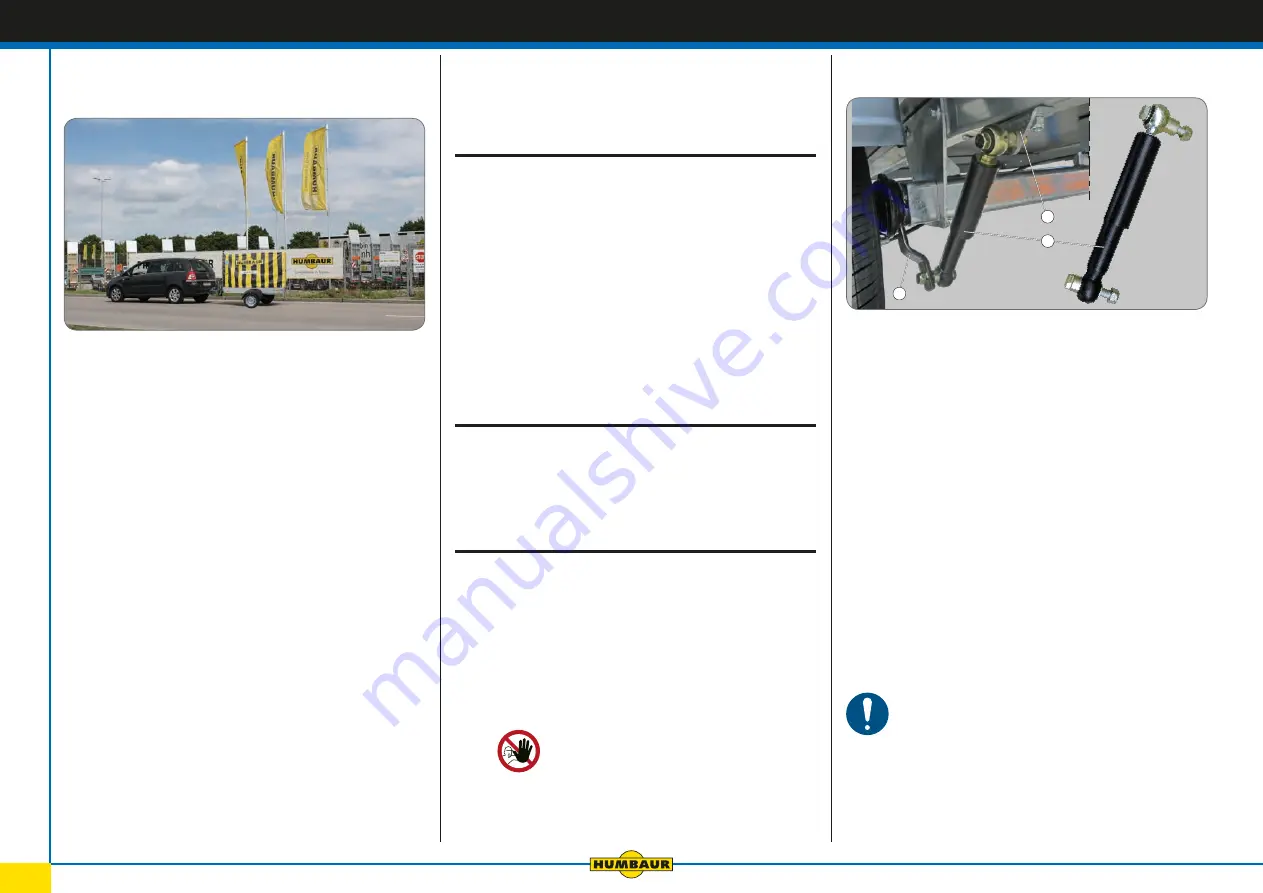
38/56
V 2019/01
Original Operating Instruction Manual
9
Driving with the towing vehicle and
trailer
H - 96
Driving with the towing vehicle and trailer
►
Carry out a departure check.
►
Check the points / components systematically.
- see section 6 “Commissioning“
►
Pay attention to the general safety instructions.
►
Before setting off, make sure that the generally permitted
combined dimensions of the trailer and load are no more
than 4 m high and 2.55 m wide (according to Sec-
tion 22, paragraph 2 of StVO (German Road Traffic Act)).
►
Before setting off and during breaks on the journey, make
sure that the load is adequately secured.
►
Before setting off, check that optional accessories such
as side wall extension / tarpaulin / H-frame / supports,
etc. are closed / secured.
Driving instructions
•
The driving stability of the vehicle and trailer deteriorates
as the driving speed increases - especially around bends.
►
Adapt your speed to the road and weather conditions.
►
Drive carefully on inclines when the trailer is loaded -
drive more slowly, apply brakes.
►
Do not exceed the maximum speed permitted outside of
built-up areas (highways, motorways, main roads, dual
carriageways).
•
- In Germany this means max. 80 km/h or 100 km/h
respectively.
•
Side wind that occurs suddenly, e.g. on bridges, when
overtaking, when changing terrain, can cause the car and
trailer to start snaking.
►
Slowly reduce the speed.
►
Avoid hectic / jolting steering manoeuvres.
Braking style
•
The braking style for a car and trailer is different than that
of a car without a trailer.
•
The braking distance increases as the load increases.
•
The ABS system on your car does not control the overrun
device of a braked trailer.
►
If you do not have any experience in driving a car with a
trailer - then carry out brake tests on a suitable site first.
►
Start braking early on.
►
Do a test brake before every journey.
►
For trailers with an overrun brake, initially brake gently,
then brake harder - this will prevent the wheels from
locking.
•
The turning circle of long trailers is larger and the follow-
up curve is smaller.
►
Pay attention to the required turning circle when manoeu
vring a vehicle with a trailer attached.
►
Do not steer too sharply - to avoid a collision between the
trailer and the car.
Reversing
•
When reversing, the view to the rear is blocked by the
load or the trailer body.
►
Be especially careful when reversing.
Please note that it may be necessary to turn the steering
wheel the opposite way.
►
Practice reversing in a suitable area.
►
If necessary, allow someone to guide you.
►
Keep people away from the back of the trailer.
Make sure that you can always see the person
in your wing mirror.
9.1 Driving at 100 km/h
H - 97
1
2
3
Wheel shock absorbers fitted
1. Wheel shock absorbers (set)
2. Bracket on the chassis
3. Axle bracket
In Germany, your trailer can be licensed for a top speed of max.
100 km/h. In other countries, the top speed for cars with trailers
outside built-up areas may vary.
Comply with the national road traffic regulations.
Functional explanation
•
Wheel shock absorbers absorb the bumps when driving
your trailer. This increases the driving comfort and
improves the road handling of your trailer.
•
Wheel shock absorbers are required to license a trailer to
travel at speeds of 100 km/h.
•
Wheel shock absorbers you have installed yourself
(for 100 km/h) need to be tested and approved by a type
approval authority such as TÜV.
Wheel shock absorbers may only be retrofitted at the
attachment points provided!
Installation may only be carried out with original spare
parts and by specialist personnel.
►
Always drive at an appropriate speed.
►
Do not drive faster than 100 km/h.
















































